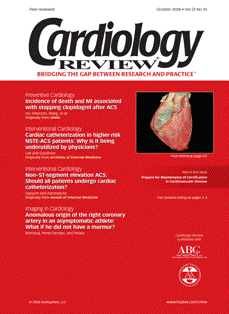Early invasive or selective invasive strategies for ACS patients
Treatment of stable patients with acute coronary syndrome (ACS) is controversial. Until recently, large randomized clinical trials had indicated that an "early" invasive strategy with routine cardiac catheterization reduced the likelihood of recurrent cardiovascular events when compared with a more "selective" approach, in which stable patients were referred to cardiac catheterization based on high-risk features on noninvasive stress imaging or because of a failure in initial medical therapy.
Treatment of stable patients with acute coronary syndrome (ACS) is controversial. Until recently, large randomized clinical trials had indicated that an “early” invasive strategy with routine cardiac catheterization reduced the likelihood of recurrent cardiovascular events when compared with a more “selective” approach, in which stable patients were referred to cardiac catheterization based on high-risk features on noninvasive stress imaging or because of a failure in initial medical therapy.1 The publication of the ICTUS (Invasive versus Conservative Treatment in Unstable Coronary Syndromes) trial in 2005, however, found that an early invasive strategy did not reduce the rate of death or myocardial infarction (MI) among patients with elevated cardiac biomarkers, forcing cardiologists to reassess this paradigm.2
Recent systematic reviews and meta-analyses have attempted to better understand and potentially resolve these disparate findings.3,4 Most have suggested that an early invasive strategy significantly reduces recurrent cardiovascular events, especially when limited to contemporary trials published after 2000. In contrast, the study by Qayyum and Adomaityte found no evidence favoring an early invasive strategy.5 This study has 2 key strengths: (1) it included data from all previous trials that evaluated this issue and (2) it conducted several sensitivity analyses that help clarify potential sources of heterogeneity across the trials. The most interesting of these sensitivity analyses suggested that removal of the ICTUS trial from the meta-analysis significantly changed their conclusions by leading to findings that favored an early invasive strategy.
Why would removal of the ICTUS trial impact their findings so substantially? First, the ICTUS trial differed from other contemporary trials in that it used a definition for periprocedural MI that included any elevation in plasma creatine kinase muscle-brain fraction above the upper limit of normal. While supported at the time by an American College of Cardiology/European Society of Cardiology consensus statement, this definition led to a 50% increase in rates of MI in the group randomized to the early invasive strategy. More recent consensus statements now define MI after percutaneous coronary intervention as biomarker elevations greater than 3 times the upper limit of normal.6 If this definition had been used in ICTUS, it would have eliminated many of the MIs documented with the early invasive strategy.
Another second critical feature of the ICTUS trial is that it used a selective invasive strategy with relaxed criteria for cardiac catheterization referral. When compared with other contemporary trials, this led to a high rate of coronary angiography during initial hospitalization (ie, >50%) and subsequent revascularization. The significance of this feature is highlighted in the study reported by Lee and Goodman, a large observational analysis of 2136 patients across Canada that investigated potential reasons for not referring patients with ACS for cardiac catheterization.7 Importantly, among the reasons provided by the treating physician as to why patients were not referred for catheterization, 68% of patients were thought to be either “not at high enough risk” or that “clinical trial evidence did not support an early invasive strategy.” However, 59% of these patients were found to have an elevated risk based on their thrombolysis in MI (TIMI) risk scores (TIMI risk score, 3-7).
Highlighting heterogeneity across trials can be one of the most important messages of any meta-analysis. Documenting potential reasons behind “evidence-to-practice” gaps in real-world settings is a critical goal of observational studies. As in this case, the findings from the meta-analysis and large observational analysis compel us to revisit the trials themselves to better understand why differences existed and how they may affect decisions in clinical practice. The studies by Qayyum and Adomaityte and Lee and Goodman support the hypothesis that early invasive and selective invasive strategies are both viable and defendable approaches and that there may be no absolute “right” or “wrong” option. This is especially true when the threshold for cardiac catheterization referral and subsequent revascularization is set appropriately. These articles re-emphasize the need for clinicians to factor individual circumstances and preferences into their decision making for optimizing patient-centered care. The articles ultimately support current American College of Cardiology/American Heart Association guidelines, which suggest that both early invasive or selective invasive therapies are reasonable options for ACS patients without high-risk features and that treatments should be tailored to the patient.
